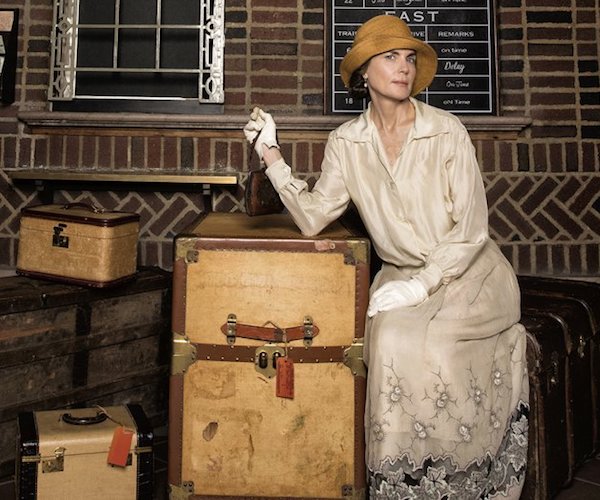Film Review: “The Chaperone” — Smothered in the Spiffy
By Tim Jackson
The Chaperone plays like a sanitized look at female independence and sexual desire for the prudish over-50s crowd.
The Chaperone, directed by Michael Engler. Screening at the Kendall Square Cinema.

Elizabeth McGovern in “The Chaperone.”
Julian Fellowes’ marvelous writing for PBS’s Downton Abby kept viewers riveted for six seasons and 52 episodes. He also wrote Robert Altman’s Gosford Park. Both stories effortlessly juggled multiple characters and simultaneous storylines. Alas, Fellowes’ film adaptation of Laura Moriarty’s novel The Chaperone loses focus despite the fact it has only two major characters to keep track of. Scenes unfold predictably, filled with dialogue that is mostly an accumulation of clichés. Adding insult to injury: the hackneyed is revealed through awkward flashbacks. Yes, the film serves up a glossy representation of early 20th century New York; the costumes are handsome and there are lively set pieces in the Masterpiece Theater mode. But, with a running time of just over 90 minutes, the narrative’s themes of sexual liberation and arriving at wisdom in mid-life never rise about the humdrum.
The titular chaperone, Norma (Downton Abby regular Elizabeth McGovern), has volunteered her services to look after 16-year-old Louise Brooks (Haley Lu Richardson), who has been accepted into a modern dance academy in New York. The troupe is populated by, among others, Ruth St. Denis and Ted Shawn (Robert Fairchild from the New York City Ballet). The pair travel from Kansas to the Big Apple: Norma does her best to keep the 16-year-old Louise out of trouble and the arms of men. Meanwhile, Norma, who as an infant was sent on an “orphan train” to Kansas from New York, begins to search for her birth mother. The Mother Superior of the New York Home for Friendless Girls refuses Norma access to her adoption records. With the help of an immigrant caretaker named Joseph (Géza Röhrig from Son of Saul), she steals the documents and contacts her birth mother (Blythe Danner). By way of flashbacks, we learn that years earlier Norma caught her husband in flagrante delicto with another man. A cold marriage results. Cue a middle age fling with Joseph. Meanwhile, the feisty Louise is harvesting her teen oats while she becomes the best dancer in the troupe. She catches the eye of its director, Ted Shawn, to the consternation of Ruth St. Denis. Unfortunately, Brooks’ colorful shenanigans merely serve as background to the chaperone’s identity crisis.
Louise Brooks did, in fact, become a silent film star who generated a notorious reputation for, to put it mildly, sexual antics and multiple partners. As the result of sexual abuse as a child, Brooks felt the need to be dominated, yet she was outspoken and liberated about her libido. The film renders her explorations of sexuality far too gently. Richardson, who is a dancer, is excellent as the sensuous Brooks, but the fire in the character’s loins is merely hinted at. In addition, Norma doesn’t demand much from her young charge, who is pretty compliant to her chaperone’s advice. Interpersonal tensions are muted and romance stifled. The Chaperone plays like a sanitized look at female independence and sexual desire for the prudish over-50s crowd.
McGovern has been given too little to work with and Richardson’s Brooks never becomes more than a naughty teenager. I was hoping for some explosive moments. The set-up is promising: female protagonists from different generations clash in Roaring ’20s America, a time when attitudes to femininity were rapidly changing. Each might discover something about herself while learning to respect the other. But there is no real payoff to the contrast: the film loses its way toward the end, when the story leaps ahead 20 years. The conflict might have generated some passion — but not when smothered in the spiffy. The Chaperone did make me want to read Brook’s memoir, Lulu in Hollywood.
Tim Jackson was an assistant professor of Digital Film and Video for 20 years. His music career in Boston began in the 1970s and includes some 20 groups, recordings, national and international tours, and contributions to film soundtracks. He studied theater and English as an undergraduate, and has also has worked helter skelter as an actor and member of SAG and AFTRA since the 1980s. He has directed three feature documentaries: Chaos and Order: Making American Theater about the American Repertory Theater; Radical Jesters, which profiles the practices of 11 interventionist artists and agit-prop performance groups; When Things Go Wrong: The Robin Lane Story, and the short film The American Gurner. He is a member of the Boston Society of Film Critics. You can read more of his work on his blog.
